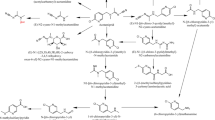Abstract
Insecticides were administered to rats as single doses, oral and IP, at approximately 1/10 their acute oral LD50 levels, or in the diet at concentrations where the daily intake was equivalent to the single doses. Carbofuran decreased the rate of urinary elimination of carbaryl-14C from rats whereas Ruelene tended to increase the rates. However, the changes were minor, 12% or less, and the nature of the carbaryl metabolites was not altered. Carbaryl and carbofuran caused a reduction in liver protein of rats injected with the carbamates for five days, but had no affect when fed in the diet for 40 days. DDT increased the liver protein when injected but not when fed in the diet. When administered in combination, by injection or in the diet, DDT and carbaryl did not modify the protein content of the liver. Liver and kidney microsomes of rats fed DDT in the diet, alone or with carbaryl, resulted in increased oxidase activity. Neither of the compounds affected microsomal glucuronidation of 1-naphthol. In a four-week feeding study, the rate of weight gain was 15% less in animals fed carbaryl plus Ruelene or coumaphos plus Ruelene than in the control rats. No significant difference from the controls was observed with carbaryl or carbaryl plus carbofuran. Feeding these compounds did not affect urine pH; but the urea content was increased by all treatments and the glucose content increased by all except treatment with coumaphos plus Ruelene.
Similar content being viewed by others
References
Benedict, S. R.: The detection and estimation of glucose in urine. J. Am. Med. Assoc.57, 1193 (1911).
Casida, J. E.: Mixed-function oxidase involvement in the biochemistry of insecticide synergists. J. Agr. Food Chem.18, 753 (1970).
Conney, A. H.: Pharmacological implication of microsomal enzyme induction. Pharmacol. Rev.19, 317 (1967).
Dorough, H. W., and J. E. Casida: Nature of certain carbamate metabolites of the insecticide Sevin. J. Agr. Food Chem.12, 294 (1964).
Dorough, H. W.: Metabolism of insecticidal methylcarbamates in animals. J. Agr. Food Chem.18, 1015 (1970).
Fearon, W. R.: The carbamide diacetyl reaction: a test for citrulline. Biochem. J.33, 902 (1939).
Fouts, J. R.: The stimulation and inhibition of hepatic microsomal drug-metabolizing enzymes with special reference to effects of environmental contaminants. Tox. Appl. Pharmacol.17, 804 (1970).
Gillett, J. W., and T. M. Chan: Cyclodiene insecticides as inducer substances and inhibitors of microsomal epoxidation. J. Agr. Food Chem.16, 590 (1968).
Hart, L. G., and J. R. Fouts: Further studies on the stimulation of hepatic microsomal drug metabolizing enzyme by DDT and its analogs. Arch. Expt. Pathol. Pharmakol.249, 486 (1965).
Kenaga, E. E., and W. E. Allison: Commercial and experimental organic insecticides. Bull. Entomol. Soc. Amer.15, 85 (1969).
Lowry, O. H., N. J. Rosenbrough, A. L. Furr, and R. J. Randall: Protein measurement with Folin phenol reagent. J. Biol. Chem.193, 265 (1951).
Mehendale, H. M., and H. W. Dorough: Glucuronidation mechanisms in the rat and their significance in the metabolism of insecticides. Pestic. Biochem. Physiol.1, 307 (1971).
Oonnithan, E. S., and J. E. Casida: Oxidation of methyl and dimethyl carbamate insecticides by microsomal enzymes and anticholinesterase activity of the metabolites. J. Agr. Food Chem.16, 28 (1968).
Rosenberg, P., and J. M. Coon: Increase of hexobarbital sleeping time by certain anticholinesterase. Proc. Soc. Exp. Biol. Med.98, 650 (1958).
Street, J. C.: Organochlorine insecticides and the stimulation of liver microsomal enzymes. Ann. N. Y. Acad. Sci.160, 274 (1969).
Welch, R. M., W. Levin, and A. H. Conney: Insecticide inhibition and stimulation of steriod hydroxylases in rat liver. J. Pharmacol. Exp. Therap.155, 167 (1967).
Author information
Authors and Affiliations
Rights and permissions
About this article
Cite this article
Lin, T., Dorough, H.W. Influence of insecticide exposure on thein vivo andin vitro metabolic activity of rats. Arch. Environ. Contam. Toxicol. 2, 364–377 (1974). https://doi.org/10.1007/BF02047101
Received:
Accepted:
Issue Date:
DOI: https://doi.org/10.1007/BF02047101




